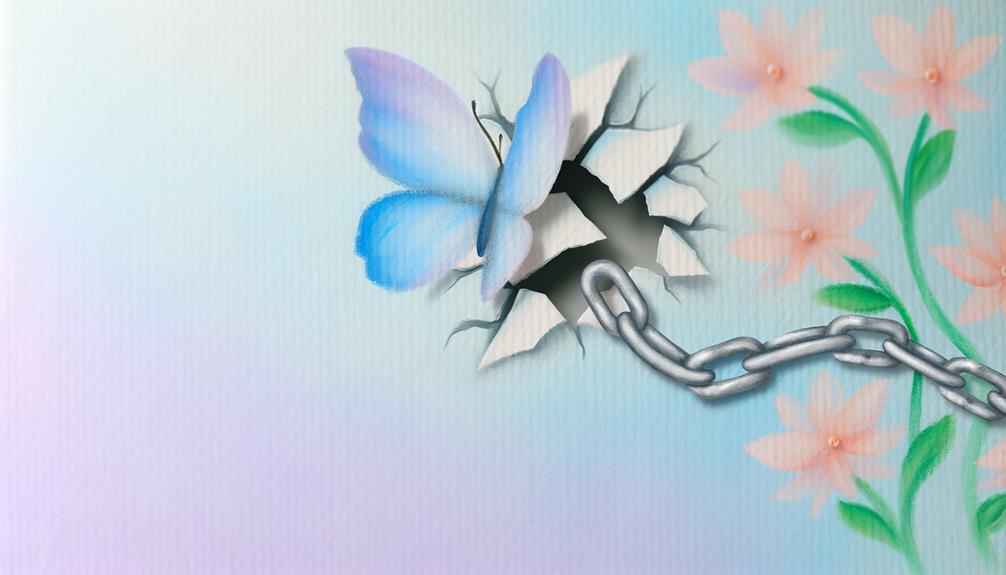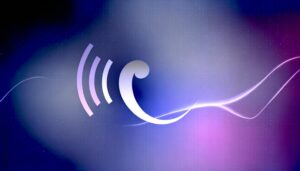What Is the Symbol for Eating Disorder Recovery?
Symbols for eating disorder recovery like the butterfly and semicolon provide meaningful representation for hope, resilience, and personal growth. The butterfly, emblematic of transformation and renewal, offers a powerful metaphor for change.
The semicolon signifies continuity and the choice to persist despite adversity. These symbols serve therapeutic purposes, bridging communication gaps and enhancing psychological recovery.
They also reduce stigma and foster a supportive community. By integrating these icons into one's recovery narrative, individuals can find strength and motivation.
Explore further to understand how these symbols play an essential role in the holistic approach to eating disorder recovery.

Key Takeaways
- The butterfly symbolizes transformation, growth, and renewal in eating disorder recovery.
- The semicolon represents hope, resilience, and the decision to continue despite challenges.
- The NEDA symbol signifies strength and recovery from eating disorders.
- The lotus flower symbolizes rebirth, purity, and resilience in the recovery journey.
- Recovery symbols serve as visual affirmations of progress and empowerment.
The Power of Symbols

Symbols have a profound ability to encapsulate complex emotions and experiences, serving as potent tools in the journey of eating disorder recovery.
The utilization of symbols can provide a tangible representation of hope, resilience, and personal growth. Research supports that visual symbols can greatly enhance psychological recovery by fostering a sense of identity and belonging.
For example, a semicolon often symbolizes continuation and overcoming adversity, resonating deeply with individuals on recovery paths. Clinically, incorporating symbols into therapeutic practices can aid in bridging communication gaps, offering comfort and encouragement.
This approach is rooted in evidence-based practices that emphasize the importance of holistic, person-centered care, ensuring that patients feel seen and understood in their recovery journey.
Historical Background
The historical background of eating disorder recovery symbols can be traced back to early representations that sought to provide hope and solidarity to those affected.
Over time, these symbols have evolved, reflecting a deeper understanding of the complexities associated with eating disorders and the recovery process.
This section will explore the origins and transformation of these icons, underscoring their significance in fostering a sense of community and resilience.
Origins and Early Symbols
Tracing the origins and development of symbols related to eating disorder recovery reveals a rich historical context marked by evolving understanding and increased awareness of these complex conditions.
Early symbols were often rudimentary, reflecting a nascent recognition of eating disorders. Initial efforts to create a visual representation for recovery emerged in therapeutic settings, where clinicians sought to provide patients with a tangible emblem of hope and progress.
The semicolon, for example, was adopted to signify continuity and resilience. Another early symbol was the butterfly, representing transformation and rebirth. These symbols served not only as personal motivators but also as tools for raising public awareness and reducing stigma, fostering a more supportive environment for individuals battling eating disorders.
Evolution of Recovery Icons
Building upon the foundational symbols of the semicolon and butterfly, the evolution of recovery icons has mirrored the growing sophistication in our understanding of eating disorders over the decades.
Initially, these symbols primarily signified hope and transformation. As clinical knowledge expanded, newer icons began to reflect nuanced aspects of recovery, such as the intertwined heart and fork, representing self-love and nourishment.
Evidence-based practices have underscored the importance of holistic approaches, inspiring symbols that integrate mind, body, and spirit. These icons serve not only as beacons of hope but also as reminders of the complex journey toward wellness.
Their continued evolution underscores the importance of empathy, resilience, and a thorough approach to eating disorder recovery.
The Butterfly Symbol

The butterfly symbol has profound origins and historical significance in the context of eating disorder recovery, representing transformation and renewal.
Clinically, it embodies the recovery journey's challenges and triumphs, offering a metaphor for growth and healing.
Personal stories and testimonials further illustrate how this symbol resonates deeply with individuals aiming for recovery, providing hope and inspiration.
Origins and Historical Significance
The butterfly symbol, widely recognized within the realm of eating disorder recovery, encapsulates both the metamorphic journey and profound personal transformation inherent in overcoming these conditions. Historically, the butterfly has been emblematic of change, growth, and renewal across various cultures. Its adoption in eating disorder recovery stems from its representation of a complete metamorphosis: from a caterpillar, perceived as limited and constrained, to a butterfly, symbolizing freedom and renewal.
| Historical Significance | Symbolism | Cultural Setting |
|---|---|---|
| Ancient Greece | Rebirth | Psyche and soul |
| Native American | Change | Transformation |
| Japanese Culture | Joy | Renewal |
The enduring relevance of the butterfly in this context offers a powerful visual metaphor for the challenging yet hopeful process of recovery.
Symbolism in Recovery Journey
In the context of eating disorder recovery, the butterfly symbolizes the profound transformation and resilience required to overcome these challenging conditions. Clinical studies emphasize that recovery involves a metamorphosis, akin to the butterfly's journey from caterpillar to chrysalis to its final, liberated form.
This symbol resonates deeply within therapeutic settings, representing hope, renewal, and the strength to emerge from a period of intense struggle. The butterfly's delicate yet resilient nature mirrors the fragile state of individuals in recovery, illustrating their courage and determination.
Evidence-based therapies often incorporate such symbolism to foster a positive mindset and facilitate emotional healing, underscoring the butterfly's role as an emblem of enduring change and personal growth in the recovery journey.
Personal Stories and Testimonials
Many individuals in recovery have found profound meaning in the butterfly symbol, as reflected in their personal stories and testimonials. This symbol often represents transformation, hope, and resilience, mirroring the metamorphosis from the struggles of an eating disorder to recovery.
Clinical evidence suggests that symbols can serve as powerful motivators in the healing process. Testimonials frequently highlight how the butterfly's journey from caterpillar to winged adult resonates deeply with their own recovery narratives. These stories underscore the importance of visual and symbolic representation in mental health recovery, providing tangible hope and a sense of shared experience.
For many, the butterfly becomes a daily reminder of their strength and potential for rebirth, fostering a compassionate and supportive community.
The Semicolon Symbol
Although commonly associated with mental health and suicide prevention, the semicolon symbol has also emerged as a powerful emblem of hope and continuity in the journey of eating disorder recovery.
This punctuation mark, used in writing to indicate a pause rather than an end, metaphorically represents resilience and the decision to continue despite challenges.
Clinical studies suggest that symbols, like the semicolon, can serve as therapeutic tools, reinforcing positive behavior and self-affirmation.
For individuals battling eating disorders, the semicolon symbolizes their commitment to recovery and the ongoing narrative of their lives. Its adoption within this context provides a simple yet profound visual reminder that their story is not over, instilling a sense of empowerment and purpose.
Other Recovery Symbols

Beyond the semicolon, various other recovery symbols have been embraced by the eating disorder community, each carrying its own unique significance and therapeutic potential.
The NEDA (National Eating Disorders Association) symbol, a stylized heart, signifies strength and recovery, promoting awareness and solidarity.
Another prevalent symbol is the recovery butterfly, representing transformation and the journey toward healing.
The lotus flower, often used in Eastern philosophies, symbolizes rebirth and purity, reflecting the resilience of those in recovery.
These symbols serve not only as personal motivators but also as public declarations of commitment to recovery.
Evidence suggests that such symbols can foster a supportive environment, enhancing emotional resilience and providing a sense of belonging within the recovery community.
Personal Stories
Personal stories of recovery offer profound insights into the lived experiences behind these symbols, illustrating both the challenges and triumphs faced by those on the path to healing.
These narratives reveal the complexities of eating disorders, capturing the struggle with self-acceptance and the arduous journey toward reclaiming one's health.
Clinically, such stories underscore the importance of a multidisciplinary approach, integrating medical, psychological, and nutritional support. Evidence-based treatments, such as Cognitive Behavioral Therapy (CBT) and Family-Based Treatment (FBT), often emerge as pivotal elements in recovery.
The compassionate sharing of personal experiences not only fosters a deeper understanding but also serves as a beacon of hope for others. By acknowledging these individual journeys, we can better appreciate the resilience and strength inherent in the recovery process.
Symbolic Tattoos
In the world of eating disorder recovery, symbolic tattoos emerge as powerful visual affirmations of resilience and healing. These tattoos often serve as personal reminders of the journey from struggle to strength, encapsulating meaningful symbols such as butterflies, semicolons, or unique designs tailored to individual experiences.
According to clinical observations, these permanent marks can provide a sense of empowerment, reinforcing a person's commitment to recovery. Research highlights that symbolic tattoos can enhance self-esteem and offer a tangible connection to the recovery process.
While the decision to get a tattoo is deeply personal, for many, it represents a transformative milestone. It is essential, however, to approach this decision thoughtfully, considering both psychological and physiological implications to ensure it aligns with one's recovery goals.
Finding Your Symbol
Choosing a personal symbol for eating disorder recovery demands thoughtful contemplation and, often, guidance from therapeutic professionals to guarantee it resonates deeply with the individual's healing journey.
This process is rooted in self-reflection and may involve exploring various aspects of one's recovery experience. Clinical evidence suggests that symbols can provide significant emotional support and motivation.
For instance, imagery related to strength, growth, or rebirth may be particularly empowering. Collaboration with a therapist can help assure that the symbol chosen aligns with therapeutic goals and personal values.
It is essential for the symbol to evoke a sense of hope and resilience, serving as a tangible reminder of progress and commitment to recovery.
Conclusion
In the journey of eating disorder recovery, symbols serve as beacons of hope and resilience. Like lighthouses guiding ships through turbulent waters, these symbols provide a sense of direction and community.
Whether butterflies, semicolons, or personal emblems, these symbols play a crucial role in offering support and encouragement to individuals on their path to healing.
Through historical context and individual narratives, the profound impact of these symbols becomes apparent. Understanding and embracing these symbols can greatly contribute to the recovery process, offering both strength and solidarity to those journeying the path to healing.






